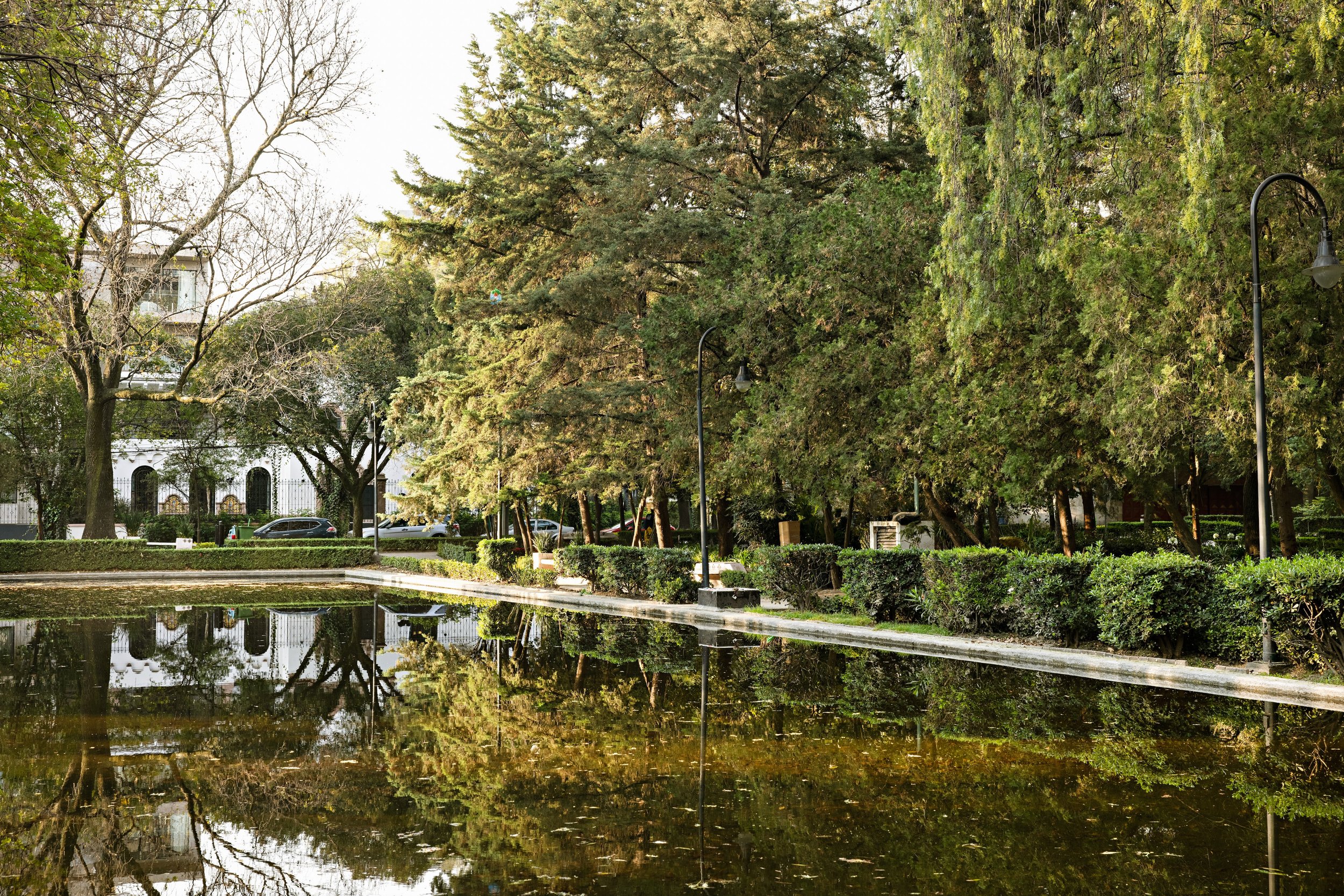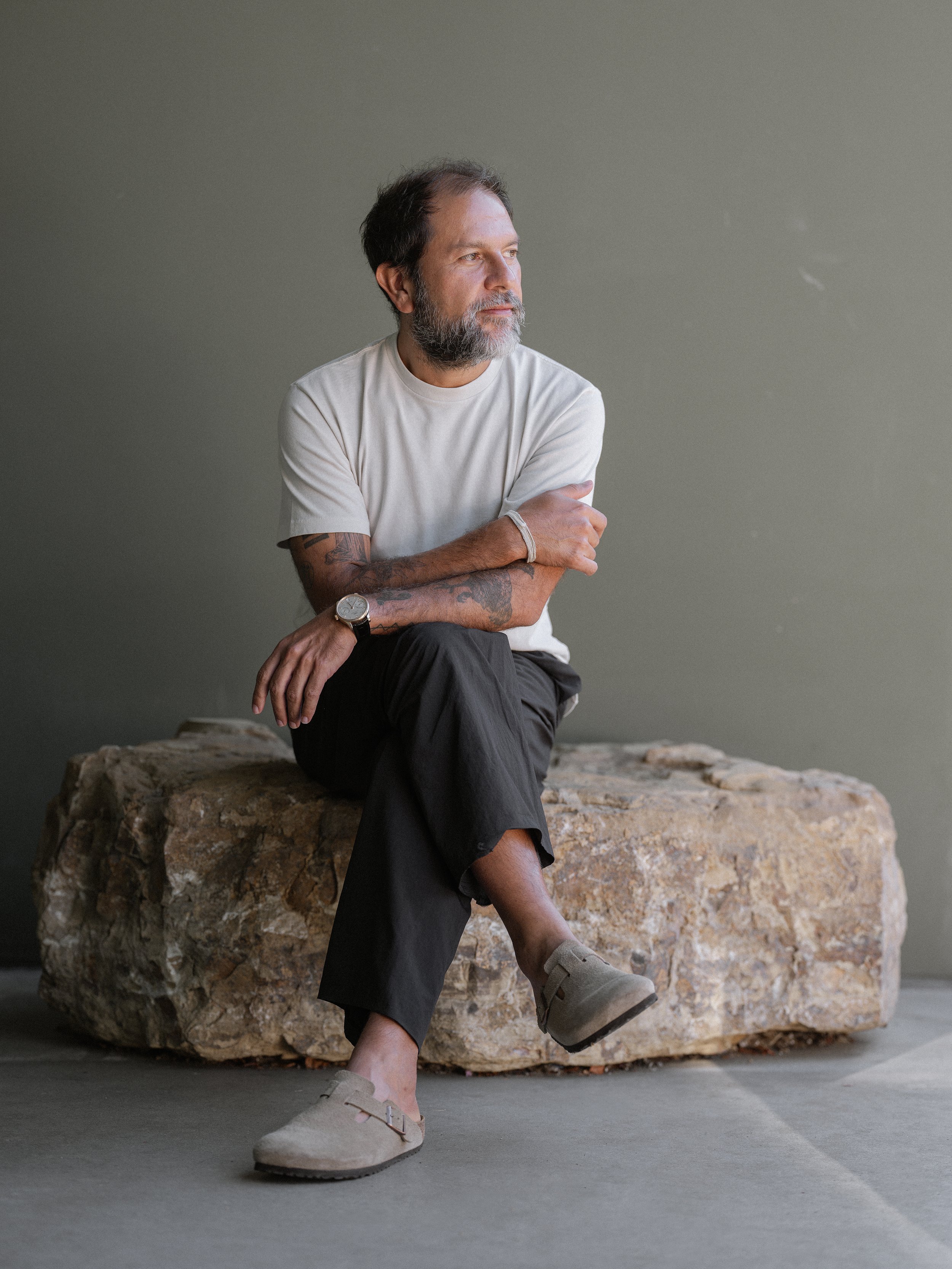36 Delicious Hours in Mexico City
The gorgeous entrance of Casa Polanco, photos by Karyn Millet
I was told once that Chef Enrique Olvera’s cooking is all about time, and I remember thinking—time? How can a dish be all about time? In Mexico City, you can see a white piano, dangling in midair above an ancient body shop; you can squint up at skyscrapers that cantilever at impossible angles over street vendors. Modernity in CDMX constantly pushes up against the past.
My home base for a quick weekend trip was the gorgeous and gracious Casa Polanco, a 1940s mansion in the area’s signature neo-Baroque style—white with elaborate stone carvings around the windows and doors—that has been recently and cleverly expanded by architect Claudio Gantous with a modern wing, all glass and wood—past and future in dialogue, again.
Aside from the spectacular Irish Green marble that the owner, Octavio Aguilar, fell in love with and laid out like an undulating carpet throughout the house, the décor was luxurious but understated in a way that felt freshly tailored. My room was in the original wing, where nubbly grey fabric and delicate wallpaper set off the scrolled details and swooping ironwork of the original house.
Staying there felt like being the lucky guest at a friend’s house with impeccable taste, down to the honor bar in the library, the courtyard with its leafy tree, the table laid out with fruit, the lovely staff and my spacious apartment with its soft couches and massive stone tub.
During the 1930s, the Polanco neighborhood north of Chapultepec Park were the gardens of San Juan de Los Morales’ hacienda, which subsequently became subdivided for a vibrant Jewish and Lebanese population that promptly moved in. The neighborhood, much changed and upscale, is still a walking wonderland, with the Lincoln Park “mirror basins” of water directly across the street, and world-famous Pujol a quick 10 minutes away.
The mirror basin of Lincoln Park
I had had the pleasure of speaking with Chef Enrique Olvera in LA the week before at Atla, his new Venice restaurant. As Olvera told me, each of his eateries (including Cosme in NYC and Damián/Ditroit Taquería in DTLA) are “a bit like siblings, share a DNA, and yet each of them is completely different. In every project, we are trying to stay authentic to our style and our heritage, but also to showcase what’s going on in that very specific place.” Damian is “dance-y, more rhythmical,” Cosme is “high energy,” while Atla is “more casual, more home-style, not the ceremonial pre-Hispanic cooking that’s often more culture than preparation, but cleaner everything, like chicken soup.” Of all the twelve Casamata restaurants, Pujol is, of course, the mothership.
Chef Enrique Olvera, photo by Araceli Paz
It felt low-key the night I went, with a somber courtyard entrance and a warren of serious dining rooms softly lit by candles (scentless, so as not to interfere with the food). Each individual menu, dated and sealed with sealing wax, is an experience, a journey that—again—dances with the future while resonating with the past.
For me, there are two kinds of chefs, those who do familiar dishes next-level well, and the chefs who create. Olvera uses flavors like colors, decorating, combining and innovating, and yet he’s also always thinking of his heritage and what matters to him.
On the day we spoke, he told me passionately about connections he’s made with Valle de Bravo farmers, his mezcal project—"We wanted to do something good that wasn’t too expected; you can really taste the agave, and it’s distilled by a couple, which is nice,” how he’s cooking more at home—“where I get my ideas,” and how he’s spending more time with his family. His daughter, Gaia has, he suspects, the soul of a chef—"I see the personality. It’s her combination of strength and sensibility.” He also told me about his tattoos—always a portal into how chefs really think and feel—the giant hen on his left arm, the canary on his right—“That’s my grandfather, who’s always taking care of me, like the canary in the coal mine”—the bicycle – “my dad, because he’s out of this world, like in ET”—and the olive branch with three figs—“my last name—Olvera Figueroas— and my three kids.”
The dinner at Pujol that night was revelatory in the way that only fine dining can be, a procession of dishes that riffed off each other and pointed towards a deeper past. There was a summer-y ceviche—scallops and sunchokes spiked with soursop juice—and an Amberjack al Pastor Tostada where the singed pineapple contrasted sharply with the smoky fish, lightly soothed by an avocado and coriander purée. The epiphany, of course, was Pujol’s famous Mole Madre, a deep brown vegetarian mole that had been added to for 3174 days—imagine!—and tasted complex as mincemeat, and a smaller interior circle of ‘new’ mole, tasting more subtly of dried fruit and chocolate and spices with no animal protein in sight.
Mole madre and mole nuovo at Pujol
Pujol’s famous churro
After collapsing on the crisp sheets in my Casa Polanco ‘second home,’ I vowed never to eat a single thing again for the rest of my life, though I woke up hungry and ready to explore. The next stop was Casa Pedregal, one of the CDMX houses designed by Luis Barragán.
Barragán’s work is all about light and space. Inside Casa Pedregal, the high ceilings and black-framed steel windows framed the electric green of the garden like ever-changing art. The house was cool and quiet, sound echoing faintly from wall to thick plaster wall like in a church. Surprisingly, the vivid pinks and aqueous blues that Barragán is so famous for were the work of Jesús “Chucho” Reyes, a well-known contemporary painter and friend who advised Barragán on his renowned palette. The colors were indeed miraculous—a honeyed light spilling onto an oiled leather chair, the seagrass green of the pool, the tiles in the bathroom that looked like mother of pearl one minute, and pink the next—but so was the scale. Light shafted in from skylights and small windows and around corners. Every move forward was mirrored by the past.
Tetelán is the museum’s café, a courtyard restaurant with acai bowls spiked with edible flowers, and a glass floor over a volcanic garden like a full-on terrarium. I even saw gardeners working below on the bright green plants dotting the rock that forms the foundation of the entire neighborhood. At Tetelán, I had a glorious taco al pastor that rivaled Pujol’s in a completely different ‘street’ way, its pineapple medallion slightly singed over a blue corn tortilla and scribbled by a strip of pink pickled onion. I also failed to resist a perfect slab of mango cheesecake, garnished with basil leaves, a combo which oddly worked.
Later that afternoon, tuckered out from the altitude, the trip, and all these visual splendors, Casa Polanco did a great job of destressing us with an excellent massage in their ‘spa cabin’ on the roof. Even better was the private dinner on the terrace—the sounds of children and dogs floating up from the park, the leaves rustling in a post-thunderstorm breeze—and their new and talented chef, Eduardo Carmona Castaneda, formerly of Restaurante Eloise. A procession of light seasonal dishes evolved from a beet carpaccio with caramelized walnuts, to a red snapper dusted with tortilla powder and finished with Asian-influenced ginger sauce, to a tangy lemon curd and crunchy meringue with a mysteriously complex cardamom sauce.
Day 2 had, I admit, some shopping involved—don’t miss Onora, where I stocked up on candelabras—before we went to Roma, the “hipster” neighborhood. We walked the streets (which very much reminded me of how much I’d loved Alfonso Cuarón’s movie, Roma), stopping for a quick guava pastry at Rosetta’s Panaderia, before hitting the spectacular Museo Nacional de Antropología. There, you get a sense of the sheer depth and vastness of the Aztec culture that’s the bedrock of modern Mexico City, and how our own culture is, by comparison, just baby steps.
Our last night we ventured out in a pelting rainstorm to Hugo’s Wine Bar. It’s one of those perfect restaurants—doing classics extremely well with added creativity—the gnocchi was epic, the natural wines were funky and interesting, and the Basque cheesecake was, well, you’ve got to go.
The following afternoon, due to come home, we just managed to squeeze a deeper exploration of charming Polanco. I was especially taken by The Service Course, a high performance bike store in a historic mansion, its sister café and restaurant project, Auna, by chef Jorge Vallejo of Quintonil fame, and a final lunch at Masala y Maíz.
Chefs Saqib Keval and Norma Listman had me at "Let’s Fight for a Feminist Future" on the menu and the pink Black Panther fists on the staff uniforms, but some of the most deliciously inventive food I’ve ever tasted sealed the deal. I especially loved ceviche verde, the shrimp with chile and vanilla ghee, and the magical cacao tamal with orange and pistachios.
After lunch, we staggered onto the plane, already missing the leafy streets of Polanco, and vowing to never eat again. Did I say that before?
The courtyard at Casa Polanco







